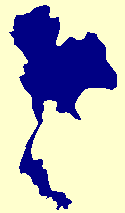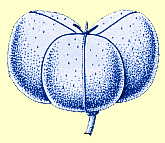
Flora of Thailand
Euphorbiaceae

 |
|
 |
Hoang Van Sam & P.C. van Welzen
Goto on this page:
Blume, Bijdr. 2: 621. 1825; Hook.f., Fl. Br. India 5: 381. 1887; Backer & Bakh.f., Fl. Java 1: 496. 1963; Airy Shaw, Kew Bull. 26: 258. 1972; Whitmore, Tree Fl. Malaya 2: 91. 1973; G.L.Webster, Ann. Missouri Bot. Gard. 81: 102. 1994; Radcl.-Sm., Gen. Euphorbiacearum: 286. 2001; Hoang Van Sam & Welzen, Blumea 49: 429. 2004; in Chayam. & Welzen, Fl. Thailand 8, 1: 254. 2005; G.L.Webster in Kubitzki, Fam. Gen. Vasc. Pl. 11: 161, Fig. 37. 2014.
Trees, monoecious. Latex white (to yellowish), abundant. Indumentum mainly absent, simple hairs in young parts and inflorescences. Stipules small, early caducous. Leaves alternate, simple, at end of twigs; petiole long, especially apically pulvinate; blade oblong, rather coriaceous, base with 2 glands above at point of petiole insertion, margin entire, penninerved. Inflorescences axillary to subterminal, cymose panicles, bisexual with central flower of each cyme pistillate, the rest staminate; peduncle long. Flowers symmatric, pedicellate; sepals 4-6(7), in two whorls, free, imbricate; petals absent; disc annular with stamens or staminodes in excavations of disc. Staminate flowers: disc lobulate, pubescent; stamens 10-20(-22), filaments free, short, connective apiculate, glandular; pistillode absent or minute. Pistillate flowers: disc cupular; staminodes many, minute; ovary 2-4-locular, hairy; ovules 1 per locule; style short, stigmas thick, apical part split. Fruits capsules, large, dehiscing septicidally into 2-valved cocci, outer layer somewhat fleshy, inner hard. Seeds large, obovoid, triangular in transverse section, naked (caruncle and aril absent).
A monotypic tropical Asian genus. In S. Thailand, Malay Peninsula, Suamtra, Java, and Borneo. Classification: Subfamily Crotonoideae, tribe Elateriospermeae.
Elateriospermum tapos Blume, Bijdr. 2: 621. 1825; Ridl., Fl. Malay Penins. 3: 252. 1924; Backer & Bakh.f., Fl. Java 1: 496. 1963; Airy Shaw, Kew Bull. 26: 258. 1972; Whitmore, Tree Fl. Malaya 2: 91. 1973; Hoang Van Sam & Welzen in Chayam. & Welzen, Fl. Thailand 8, 1: 254. 2005.
Trees, 27(-50) m high, sometimes shortly fluted with buttresses up to 2 m high; crown monopodial. Stipules triangular, 2-3 mm long. Leaves: petiole 1-8 cm long; blade elliptic to obovoate, 5-24 by 2-7.5 cm, length/width ratio 2.5-3.2, base obtuse to cuneate, apex abruptly acuminate to cuspidate; venation distinct, raised especially below, nerves 7-17 per side; young leaves red. Inflorescences up to 19 cm long, hairy; cymules 0.5-6 cm long; bracts triangular, 1-1.4 by 0.7-1 mm; peduncle 2-9 cm long. Flowers white to pale yellow, fragrant with unpleasant smell; buds white. Staminate flowers 2.4-3.5 mm in diameter; pedicel 2-7 mm long; sepals ovate, 2.5-6 by 2.2-5 mm, apex rounded, hairy outside; disc 0.8-1.3 mm long; stamens yellow, filaments 0.3-2 mm long, anthers 0.8-1.2 by 0.2-0.4 mm. Pistillate flowers 3.2-5.3 mm in diameter; pedicel 1.3-4.2(-50 in fruit) mm long, hairy; sepals ovate, 4.5-8 by 3.2-5.5 mm; disc 1-1.3 mm high; ovary 2.5-4 by 2-2.6 mm, densely hairy; style and stigma 0.3-0.5 mm long. Fruits oblong-ellipsoid, longitudinally 3-grooved, 3.2-5.3 by 2.2-4.5 cm, glabrous, from green via red to dark brown. Seeds 3.2-3.6 by 1.4-2.2 mm, brownish grey to dark brown.
T h a i l a n d.— PENINSULAR: Yala, Narathiwat, Nakhon Si Thammarat.
D i s t r i b u t i o n.— Peninsular Thailand, Malay Peninsula, Sumatra, Java (type), and Borneo.
E c o l o g y.— Common in evergreen forest. Altitude up to 600 m.
V e r n a c u l a r.— Kra (กระ), pra (ประ) (Peninsular); pi-ra (ปีระ) (Malay-Yala).
U s e s.— A tree of value, its flowering indicates the start of the rice season. The seeds are mainly used, but are usually poisonous (cyanide) when fresh (though a few races are without cyanide). The seeds can be eaten cooked or roasted, but too much may cause dizziness. On Sumatra a paste is made of the seeds (pounded with some water) and used to flavour some kinds of phrik (sambal); jungle tribes (Sakai) in Malaysia bury the paste packed in a bag or in bamboo in wet earth for a month or more, the result is a fermented paste with strong flavour, which is highly appreciated with meals. The fermented paste is also used as fish bait. The oil is seldom pressed from the seeds, pale yellow, nearly odourless and with a nice taste, to be used for cooking or as lamp oil. The wood is usually considered as excellent. The sapwood is white, the heartwood with beautiful dark brown flames. However, it is mainly used as firewood or for small items like handles of rubber tapping knives, because it takes a nice polish. It is a good contruction timber, but only the sapwood is durable, the heartwood rots easily or is attacked by termites unless treated with preservatives. The seeds make nice toys for children, they are used as toy beetles and threaded together in a game called 'conquerors'. The latex is used on Sumatra to shield dirty wounds, because it dries quickly; the Bidayuh in Sarawak apply fresh latex once per day to crack wounds on the soles of their bare feet. The latex is also used to polish blowpipes to a glossy dark sheen (Malay Peninsula).